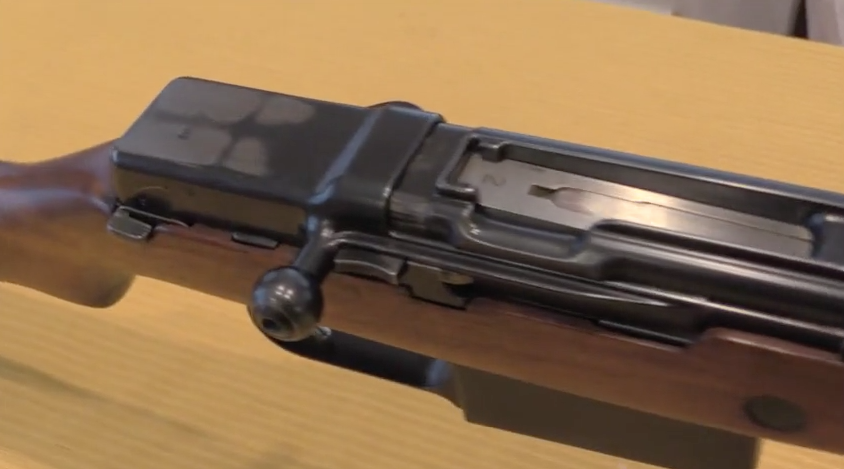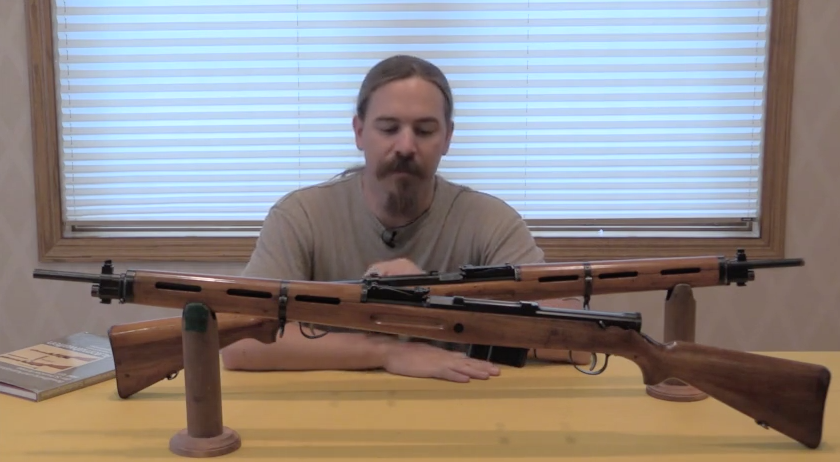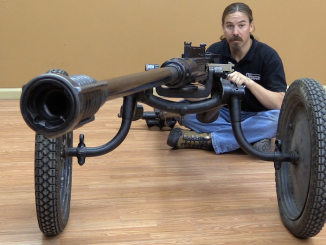The SIG 310, aka MP48, is the final evolution of SIG’s submachine gun design from the 1920s. It began as the MKM/P/S/O with a folding magazine well, wooden stock, and fancy lever-delayed operating system. Over almost 30 years of development, the wood stock and the lever-delayed system fell away, as did the really high quality finishing work. The folding magazine well and the magazine itself remained intact, however.
This final version is a very simple blowback mechanism with a similarly simple collapsing wire stock. It uses a 40-round double-feed magazine of 9x19mm ammunition, and fires at a zippy 1000 rpm. I was surprised by just how easily controllable it was despite the high rate of fire and short receiver – and also by the harmonic ringing of the wire stock when firing. While this may be an embarrassingly crude gun for the Swiss, it is a gun that most other countries would be quite proud of.
Thanks to Swiss Arms of Neuhausen for letting me do some shooting with this piece!




They may not have tried to make it pretty, but it is an elegant design.
Will you be covering some of the earlier versions? Namely interested in the MKMS, which was apparently issued to an older relative of mine in the Finnish army during the Continuation War.
Mechanical beauty is something of which the Swiss need not be ashamed! Other countries would probably ask “how did you make such wonderful toys?!” And if I’m not mistaken British soldiers would prefer this to the Sten and the Stirling had they known about it!
“(…)Stirling(…)”
Wait. Are you suggesting exchanging 4-engine bomber
https://en.wikipedia.org/wiki/Short_Stirling
for sub-machine gun?
:-DDDD
Funny one !
Sterling in very well made and thought out gun, maybe the best of its 1st generation after ww2 type.
Oops, should have said Sterling. Darn spelling error! But on the subject of the Short Stirling, the wing span was set as an intentional joke against the span limits of aircraft hangars. Because of the high wing loading caused by the relatively small wing area compared to its weight and a thick airfoil, the Stirling had a low operating altitude when fully loaded but could pull ridiculous aerobatics if needed after dropping bombs. Several German heavy fighters (who were tasked with bomber killing) were frustrated at getting out-maneuvered by a heavy bomber, especially if the British gunners were shooting back the whole time. Did I mess up?
“should have said Sterling”
To avoid confusion, please refer to this weapon as PATCHETT machine carbine.
The Stirlings wing wasnt limited by the Hangar doors. The standard RAF Bomber station hangar door opening was 120 feet wide. 99% of RAF heavies never saw the inside of a hangar anyway.
According to Stirling crews, it climbed very well and was highly maneuverable- as long as you kept the Exactor automatic throttle control turned off. Otherwise, when you needed maximum power, the Exactor would be keeping it firmly at 75%.
Since the manual stated that Exactor was to be used at all times, and a senior officer on the ground could tell by the engine note if it were on or off (and write the pilot up if it were the latter), most Stirling pilots turned it on at startup, kept it on until out of sight and hearing of the base, and then switched it off until they were feet-dry over the coast of Britain coming back.
The only drawback to the Stirling was that its unique bomb-bay setup, with four rows of “tunnels” for bombs, limited it to bombs no more than 26 inches in diameter. Thus, it could carry 500-pound GP bombs, incendiary clusters, or 1000-pound penetrating bombs, but nothing larger.
When the 2000-pound penetrating bombs and especially the 4000-pound “cookie” became the weapons of choice (especially for smashing things like the Brest and Hamburg U-boat pens and the Wizernes V-2 blockhouse, destroyed before it was finished), the Stirling was withdrawn in favor of the Lancaster and Halifax, plus the Mosquito. (Yes, even the “Mossie” could carry a 4000-pound “Cookie”- just one at a time.)
However, the Stirling continued to do yeoman service as both a glider tug (it was the only plane with the horsepower to tow the Airspeed Hamilcar assault glider that carried artillery pieces or the Locust light airborne tank), and as the “truck” delivering airdropped arms and supplies to the resistance in occupied France. Its unique bomb bay could easily accommodate up to 20 C or H type drop containers at one go, making it the “FedEx” of SOE.
“When it absolutely, positively has to be there before dawn.”
cheers
eon
“The only drawback to the Stirling was that its unique bomb-bay setup”
IIRC ground crews more liked loading of bombs to other bombers (Avro Lancaster or Handley Page Halifax?) as Stirling standing on ground has bomb bay higher than others, photo from Wikipedia query is good illustration here: https://en.wikipedia.org/wiki/File:Short_Stirling_bomber_N6101.jpg
“(it was the only plane with the horsepower to tow the Airspeed Hamilcar assault glider that carried artillery pieces or the Locust light airborne tank”
There exist photo evidence suggesting that Hamilcar was also towed behid Handley Page Halifax:
http://www.pegasusarchive.org/varsity/Photos/Pic_HamilcarHalifax.htm
http://www.pegasusarchive.org/normandy/Photos/Pic_HalifaxHamilcar.htm
Eon: the 4000 lb HC bomb was not developed for or commonly used against hard targets such as U-boat pens. It and its larger brethren were optimized for maximum HE content (75% of total weight; typical GP bomb is about 50%) and blast effects. Their main purpose was to damage normal (often civilian in practice) buildings and make them more susceptible to incendiary bombs by breaking up their structures and the ceiling in particular. They had no aerodynamic tail and were quite inaccurate even as far as “iron bombs” go.
“Mechanical beauty is something of which the Swiss need not be ashamed!”
If any sub-machine gun is shame for Swiss it is W+F Lmg-Pist 41/44 Furrer
http://www.weapon.ge/index.php?sel=1&id=439&man=&coun=29&cat=&l=en
good example how NOT to design wartime sub-machine gun
When the first first blokes with sharp sticks and pointy rocks were shouted into order inorder to fight the other tribe that were still a rabble, I bet that first ‘army’ moaned about the other side having better sticks and more pointy rocks!
Any British or Commonwealth soldier would have probably swapped his Sten for any other submachine gun, but I doubt any would swap for a Lee Enfield.
The Sterling is a different matter. Lower rate of fire than this SIG 310, durable and proven. Why would anyone swap?
The Sterling is well built but sadly not very ergonomic. From Wikipedia’s entry on the Sterling:
“The primary user complaint with the Sterling series is that there are projections in all directions, and carrying it on a sling frequently results in the weapon catching on clothing, load-bearing equipment, foliage, and doorways/hatches, as well as annoying (sometimes painful) poking of the user.”
In essence, the Sterling is a bit of a handful to carry loaded in that it will poke a right-handed user or snag on the environment if not disassembled and stuffed into a box. Unless you are in the middle of a fire-fight or simply have the Sterling prone on the edge of a trench, the gun will simply not cooperate with you in terms of personal space!
Well, for one thing, a RoF over 1,000 R/M generates less felt recoil than one between 600 and 800. The bolt is simply moving back and forth faster than the shooter’s body can move due to inertia of the latter.
French tests showed that the best RoFs for a full-auto shoulder fired weapon were either under 600, or over 1,000. This may explain why the German MG42 was more accurate than you’d expect it to be when firing at 1,200 R/M.
Interestingly, the “sweet spot” seemed to be about 450-500 R/M, which was the RoF of the U.S. M3 “grease Gun and the German MP38 and Mp40.
By comparison, the original M-16, with the early U.S. issue ammunition loaded with ball powder instead of the DuPont powder it was designed around, fired at 750-800 R/M on auto, which rather negated its other shooting qualities, which were actually perfectly adequate out to 200 meters. (The U.S. Army’s mistake was in trying to make a rifle intended to substitute for SMGs and M2 carbines substitute for an M1 Garand.)
cheers
eon
IIRC the switch to ball powder resulted in the M-16 unlocking too early which resulted in reliability issues in extraction far more serious than the RoF and shootability. That aside, gun, ammo and shooter are a system that have to work together. Why Ian was pleasantly surprised by the soft shooting of this gun, I have nothing but guesses. Your comments make sense, at least for short bursts. I was leaning to the air between the bolt (piston) and receiver/end cap (cylinder) being compressed which could give the bolt a softer “landing”.
You are correct, it was ball powder which partially caused the problem.
https://en.wikipedia.org/wiki/Ball_propellant
However it was used in other firearms since WWI, it just was not suitable for small bore barrels as introduced in form of M16. Major problem with these rifles at start was that their barrels were not chrome plated and in combination with mentioned powder.
“it just was not suitable for small bore barrels as introduced in form of M16”
Cartridge and rifle (gun) are parts of system, changing one of them without testing system as whole was unwise.
This “optimal” range of rate of fire is quite enlightening info which I believe read some place before. I tend to believe the same.
As far as M16 ‘forced’ into full auto mode of fire it was wrong direction and U.S. Army apparently realised it later while replacing it with 3-round burst. Direct gas action just does not have the capability in ROF moderation like long stroke gas piston does.
“Direct gas action just does not have the capability in ROF moderation like long stroke gas piston does.”
However there existed weapon code-named M231 FPW:
https://en.wikipedia.org/wiki/M231_Firing_Port_Weapon
which has some parts commonality with M16 and Rate-Of-Fire 1225 rpm.
While these weapons can’t be directly compared as second is lighter and lacks, comparison between M16 and M231FPW in M16 package (same size and shape as M16) would be interested in area of full-auto fire accuracy.
The main practical problem with the MP 48 I see is the very long 40 round double stack magazine, which would make firing the gun prone quite difficult. On the other hand it would probably be much more comfortable to carry with a magazine attached than the Sterling. The high ROF is not a big problem as far as the shooter has good trigger discipline and only fires shorts bursts, and like others have already pointed out, it is probably more controllable than a ROF between the 600 and 800 rpm.
“very long 40 round double stack magazine, which would make firing the gun prone quite difficult”
Is it really that long? 1st photo from top here: http://stevespages.com/pdf/sig_mp46-mp48.pdf
shows that magazine folded, its end is under muzzle.
Anyway usage of simple box magazine (stock or banana) of high-capacity in sub-machine gun mean it will stick in some direction, unless exotic solution would be applied.
As elegant a recoil-spring set up as one is likely to see. An overview of the series would be terrific, even if they weren’t all laid out on the table at the same time.
A different branch in this series is here: https://www.forgottenweapons.com/kiraly-43m-hungarys-overpowered-submachine-gun/
Looking at the stock portion that sticks out a few inches, why this gun hasn’t got a longer receiver that would lower the rate of fire, is a mystery.
Also, that hollowed out bolt (for recoil spring) is probably on the lighter side, adding to the rate of fire.
One thing that helps not to spend all the ammo too quickly is 40 round magazine, at least that.
Was this gun exported and used in some wars?
“fires at a zippy 1000 rpm”
MP 48 has also wooden-stocked sibling named MP 46, advert in English describing both sub-machine guns (or machine pistol as they call it) is available here: http://stevespages.com/pdf/sig_mp46-mp48.pdf
it states Rate-of-Fire as 800 for MP 46 and 700 for MP 48 and give muzzle velocities as 430 m/s and 400 m/s respectively. It also stated that magazine-hinge is safety, but also safety lever locking the breech can be provided on special request
“exported”
Regarding MP 48, according to http://modernfirearms.net/en/submachine-guns/switzerland-submachine-guns/sig-mp-48-mp-310-eng/
sales of MP-48 were relatively weak, with the only one major customer being the Chile
Chileans have long term favour for Swiss guns and I think they know why. Their own products have signs of high quality.
“Looking at the stock portion that sticks out a few inches, why this gun hasn’t got a longer receiver that would lower the rate of fire, is a mystery.”
———————-
I had exactly same thought. Just another inch to receiver and gun would run 100RPM less.
“Just another inch to receiver and gun would run 100RPM less”
But does they want lower Rate-of-Fire? Maybe such high Rate-of-Fire was their objective.
Since none of us was part of this development we lack the knowledge of rationale; all we are left with is to guess. Perhaps it may be as you say.
The objective is often compactness, but that comes with high ROF.
Unless it is to use bolt design similar to walther mp or some telescoping uzi,ingram etc. style.
In that case most of the bolt is around the barrel or above it, and not in the back of short receiver, which gives it a more travel. If the bolt does not hit the end of the receiver, but is stopped by the spring, its added bonus in stability (such as in mp40, sterling, probably in mp44 also etc.)
Video on Skorpion shown what rate reducer is for, and without it gun would be with its 10 and 20 round mags near to useless (skorpion scarab Ians video anyone?)
with a 40 round mag, Ian gets a respectable number of bursts from a mag, and it look so controllable I think the r.o.f. may be an advantage.
Beautiful in its simplicity.
I had the pleasure of shooting a Mac-11, another submachine gun which is amazing for its simplicity.
Slick gun; it had every right to become famous. High cyclic rate has some justification in highly mobile applications and it is backed by hi-cap magazine. The rough external finish is rather distracting, but whole package is well made otherwise. Function goes over form.
Back to the Sterling smg, This would have worn a crinkle finish
in o.d. green well.
Perfect for doing drive-by on mean streets of Geneva, after some fool stole that stash of fondue from your crib.